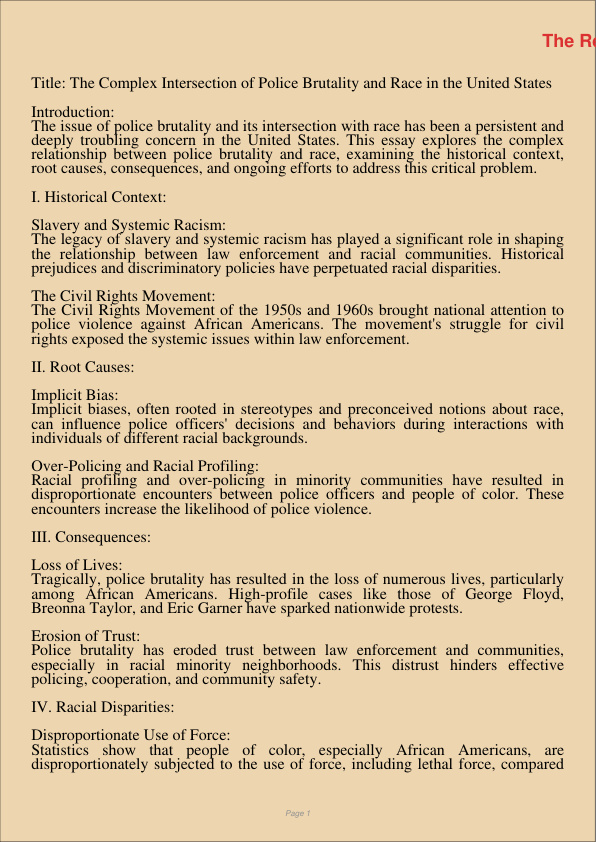The Relation Between Police Brutality And Race In The United States Of America
Jan 8, 2024
united states
police brutality
Social science
English

Title: The Complex Intersection of Police Brutality and Race in the United States
Introduction: The issue of police brutality and its intersection with race has been a persistent and deeply troubling concern in the United States. This essay explores the complex relationship between police brutality and race, examining the historical context, root causes, consequences, and ongoing efforts to address this critical problem.
I. Historical Context:
Slavery and Systemic Racism: The legacy of slavery and systemic racism has played a significant role in shaping the relationship between law enforcement and racial communities. Historical prejudices and discriminatory policies have perpetuated racial disparities.
The Civil Rights Movement: The Civil Rights Movement of the 1950s and 1960s brought national attention to police violence against African Americans. The movement’s struggle for civil rights exposed the systemic issues within law enforcement.
II. Root Causes:
Implicit Bias: Implicit biases, often rooted in stereotypes and preconceived notions about race, can influence police officers’ decisions and behaviors during interactions with individuals of different racial backgrounds.
Over-Policing and Racial Profiling: Racial profiling and over-policing in minority communities have resulted in disproportionate encounters between police officers and people of color. These encounters increase the likelihood of police violence.
III. Consequences:
Loss of Lives: Tragically, police brutality has resulted in the loss of numerous lives, particularly among African Americans. High-profile cases like those of George Floyd, Breonna Taylor, and Eric Garner have sparked nationwide protests.
Erosion of Trust: Police brutality has eroded trust between law enforcement and communities, especially in racial minority neighborhoods. This distrust hinders effective policing, cooperation, and community safety.
IV. Racial Disparities:
Disproportionate Use of Force: Statistics show that people of color, especially African Americans, are disproportionately subjected to the use of force, including lethal force, compared to their white counterparts in similar situations.
Criminal Justice System Disparities: Racial disparities extend beyond police interactions and encompass the broader criminal justice system, where people of color are more likely to be arrested, sentenced to longer prison terms, and subject to harsher penalties.
V. Ongoing Efforts to Address Police Brutality:
Police Reform: Police reform efforts seek to address issues related to training, accountability, use of force policies, and community policing. These reforms aim to reduce the incidence of police brutality.
Community Engagement: Building trust and engagement between police and communities is crucial. Efforts to promote community policing and dialogue can help bridge the gap and reduce tensions.
Legal and Policy Changes: Advocates and policymakers are pushing for legal and policy changes to hold officers accountable for misconduct. This includes body-worn cameras, civilian oversight, and revisions to qualified immunity.
Conclusion: The relationship between police brutality and race in the United States is a deeply ingrained and complex issue with historical, systemic, and ongoing dimensions. It is essential to recognize the historical context, root causes, and consequences of police brutality. Addressing this problem requires multi-faceted efforts, including police reform, community engagement, and legal and policy changes. To create a more just and equitable society, it is imperative to continue the conversation, push for meaningful reform, and promote greater understanding and empathy among all communities and law enforcement agencies.